The landscape of home defense has undergone a dramatic transformation over the last decade. Gone are the days when securing your property meant fiddling with clunky keypads, deciphering cryptic numeric error codes, or dealing with loud, centralized boxes hidden away in a closet. Today, the cornerstone of modern protection is the home security touch screen.
These sleek, interactive panels are more than just interfaces for arming and disarming your system; they are intelligent command centers that seamlessly integrate security, automation, and communication. If you are considering upgrading your protection or setting up a brand-new smart home, understanding the power and versatility of a modern touch screen security system is the essential first step toward true peace of mind. This comprehensive guide will delve into every aspect of these advanced systems, from their foundational technology to their cutting-edge features and integration capabilities.
Contents
- 1 The Evolution of Security Interfaces: Why Touch Screens Dominate
- 2 Key Features of a Premium Home Security Touch Screen
- 3 The Technology Under the Glass: Connectivity and Integration
- 4 Installation and Setup: Making the Switch to a Touch Screen Security System
- 5 Choosing the Right Touch Screen Burglar Alarm System for Your Home
- 6 Beyond Arming and Disarming: Advanced Smart Home Capabilities
- 7 Maintaining Your Touch Screen Security System for Longevity
- 8 Conclusion: Securing Tomorrow, Today
The Evolution of Security Interfaces: Why Touch Screens Dominate
The shift from traditional keypads to responsive, graphical interfaces wasn’t just a stylistic choice; it was a fundamental improvement in usability and functionality. Traditional systems often created friction—they were complex to program, difficult to troubleshoot, and often intimidating for guests or temporary residents.
From Keypads to Interactive Displays
Early home alarm systems relied heavily on hardwired connections and physical buttons, requiring users to memorize complex sequences or codes. If an alarm was triggered, the user often had to scramble to the main panel, which typically only provided basic status lights or brief numerical messages.
The introduction of the home security touch screen changed this paradigm completely. These high-resolution displays offer a visual representation of your entire security ecosystem. You can see which door is open, review live camera feeds, and check the status of individual sensors—all from one centralized location. This immediate visual feedback drastically reduces user error and enhances rapid response capabilities.
The User Experience Advantage
The core benefit of the touch screen security system lies in its familiarity. We are all accustomed to using smartphones and tablets, making the learning curve for a touch screen panel virtually non-existent.
- Customization: Users can typically customize the layout, display frequently used functions, and personalize user profiles.
- Clarity: Instead of cryptic numbers, you get clear, plain language prompts and graphics (e.g., “Front Door Open” with a corresponding icon).
- Accessibility: Modern panels often include features like larger text options, voice prompts, and simplified interfaces for children or elderly family members.
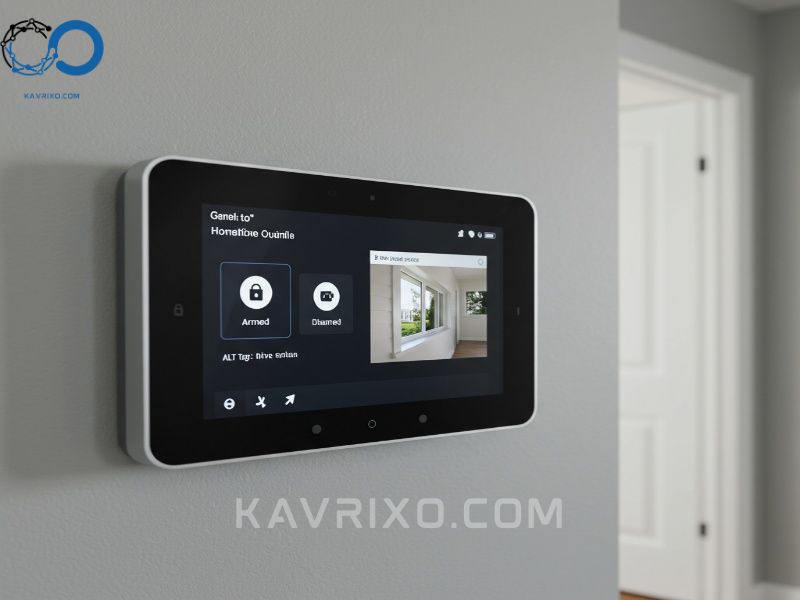
Key Features of a Premium Home Security Touch Screen
When evaluating a new security setup, the central panel—the home security touch screen—is the brain of the operation. Its capabilities dictate the effectiveness and versatility of the entire system.
Centralized Command and Control
A premium touch screen panel serves as the primary hub for all connected devices. It processes data from door/window sensors, motion detectors, glass break sensors, and environmental monitors (like smoke or carbon monoxide detectors). This centralized control allows for quick, holistic management of the property.
Crucially, many modern systems are designed to operate even during internet outages. While remote access might be temporarily disabled, the local touch screen burglar alarm system remains fully functional, relying on cellular backup communication and local processing power to sound the alarm and dispatch help if necessary.
Real-Time Video Monitoring and Access
One of the most powerful integrations enabled by the graphical interface is video surveillance. Instead of needing a separate monitor for cameras, the home security touch screen allows users to:
- View live feeds from indoor and outdoor cameras.
- Review recorded clips stored locally or in the cloud.
- Zoom in on details or pan/tilt cameras (if supported).
This feature is particularly valuable when an alarm is triggered; occupants can immediately verify the cause of the alert without needing to reach for their phone, saving precious seconds during an emergency.
Emergency Response Protocols and Two-Way Communication
Modern security panels are designed not just for deterrence, but for rapid response. They often include dedicated, one-touch panic buttons for police, fire, and medical emergencies.
Furthermore, many high-end touch screen security systems incorporate built-in microphones and speakers, enabling two-way voice communication with the monitoring center. If an alarm is tripped, the monitoring professional can communicate directly through the panel to verify the emergency, often speeding up dispatch times and reducing false alarms. This capability is a cornerstone of professional monitoring services.
Custom Zones and User Profiles
A significant improvement over older systems is the ability to create customized zones and personalized profiles.
- Custom Zones: You can set different arming modes. For example, “Stay” mode might keep perimeter sensors armed while allowing movement inside, while a custom “Night” mode might arm only the downstairs sensors and the master bedroom window.
- User Profiles: Each household member can have a unique access code, and the panel can track who armed or disarmed the system and when. For families with children or frequent visitors, this level of detailed logging provides enhanced accountability and security oversight.
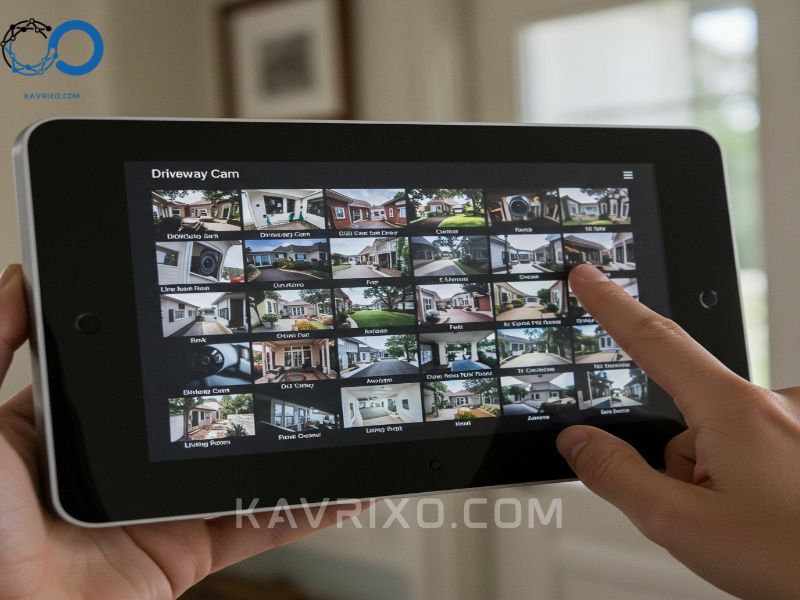
The Technology Under the Glass: Connectivity and Integration
A home security touch screen is fundamentally a gateway to the Internet of Things (IoT). Its effectiveness hinges on robust, reliable wireless communication protocols that allow it to talk to hundreds of peripheral devices seamlessly.
Understanding Wireless Protocols (Z-Wave, Zigbee, and Wi-Fi)
Unlike old hardwired systems, modern panels communicate wirelessly, which allows for easier installation and greater flexibility. The connectivity backbone typically relies on three main protocols:
- Wi-Fi: Used primarily for connecting the panel itself to the internet for remote access, cloud backup, and downloading software updates. High bandwidth is necessary for video streaming.
- Z-Wave and Zigbee: These low-power mesh networks are the workhorses of smart home security. They connect the panel to locks, thermostats, lighting controls, and small sensors. Because they use less power, batteries in sensors can last for years. The “mesh” capability means devices communicate with each other, extending the range and ensuring redundancy across the property.
Cloud Backup and Remote Access
The power of the modern touch screen security system is extended exponentially by cloud connectivity. All system data, event logs, and arming status are backed up to the cloud. This allows users to manage their system remotely via a dedicated smartphone app.
Remote access allows you to:
- Check system status instantly from anywhere in the world.
- Receive instant notifications about alarms, sensor activity, or low battery warnings.
- Arm or disarm the system for contractors or delivery personnel.
- View live video feeds and talk through connected doorbells or cameras.
This remote capability ensures that your security system is always accessible, whether you are across the street or across the continent.
Cybersecurity Concerns and Protections
While connectivity is a massive benefit, it also introduces digital vulnerabilities. A reliable touch screen burglar alarm system must prioritize robust cybersecurity measures. Reputable manufacturers implement several layers of defense:
- Encryption: All communication between the panel, sensors, and the cloud must be encrypted end-to-end to prevent eavesdropping or data interception.
- Secure Boot: This ensures that only trusted, verified software can run on the panel, protecting against malicious firmware injection.
- Automatic Updates: Regular, mandatory software updates patch newly discovered vulnerabilities, ensuring the system remains protected against evolving cyber threats.
- Separate Networks: Ideally, the security panel operates on its own dedicated, secure network channel (often cellular backup) separate from the general home Wi-Fi network, which may contain less secure devices.
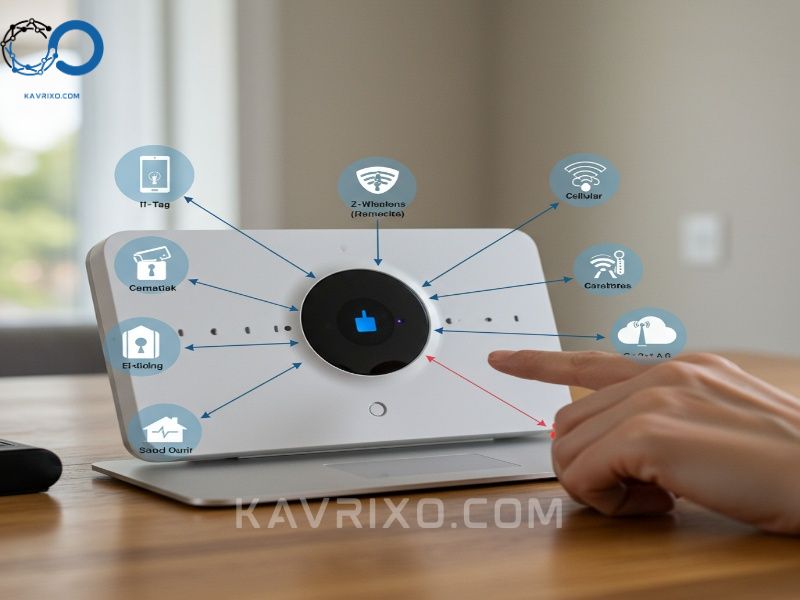
Installation and Setup: Making the Switch to a Touch Screen Security System
For many homeowners, the thought of installing a complex security system is daunting. However, due to advancements in wireless technology, the installation of a home security touch screen is far more streamlined than older, hardwired installations.
DIY vs. Professional Installation Considerations
Many modern systems are designed for simple DIY installation. The panel usually requires minimal wiring (just power) and is mounted quickly. Sensors often use adhesive backing and are paired with the panel through a simple, on-screen QR code scan or pairing process.
However, professional installation remains the preferred route for complex setups or for systems requiring professional monitoring contracts.
- Professional Advantages: Installers ensure optimal sensor placement, verify cellular signal strength, properly configure complex smart home integrations, and provide comprehensive training on using the touch screen burglar alarm system.
- DIY Considerations: DIY is cost-effective and faster, but requires the homeowner to meticulously test every component and understand the optimal placement to avoid blind spots or false alarms.
Optimal Placement for Your Touch Screen Panel
The central panel needs to be placed strategically to maximize both convenience and security.
- Primary Entry Point Access: The panel should be near the door you use most frequently (usually the garage entry or the front door) to allow for easy arming and disarming upon entry or exit.
- Central Location: Placing the panel centrally helps ensure strong wireless signals to all peripheral sensors throughout the house, especially for Z-Wave or Zigbee devices.
- Visible but Secure: While you want the panel to be accessible, it shouldn’t be immediately visible from a front window, as this could give potential intruders information about your system type or status.
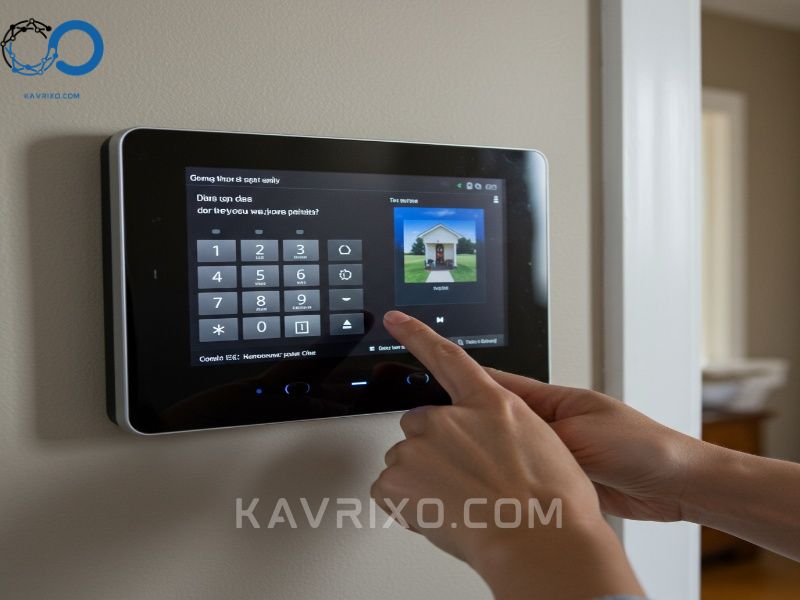
Choosing the Right Touch Screen Burglar Alarm System for Your Home
Selecting the ideal touch screen burglar alarm system involves more than just picking a brand; it involves matching the system’s capabilities to your lifestyle, property type, and security requirements.
Monitoring Options: Professional vs. Self-Monitoring
The core decision for any modern security system is how it will respond when an alarm triggers.
Professional Monitoring
This option connects your home security touch screen directly to a 24/7 central monitoring station.
- Pros: Immediate dispatch of police or fire services upon verified alarm; redundant protection even if you are unreachable or cannot answer your phone; often required for insurance discounts.
- Cons: Requires a monthly subscription fee; typically involves a contract commitment.
Self-Monitoring
In this scenario, the panel sends alerts directly to your smartphone via the cloud. You are responsible for contacting emergency services.
- Pros: No monthly fees; complete control over the response.
- Cons: Requires immediate personal attention to every alert; if you miss an alert or lose phone connection, no help will be dispatched. Self-monitoring is generally sufficient only for very low-risk areas or as a supplementary system.
Assessing System Scalability and Future Needs
When investing in a touch screen security system, always look ahead. Will the system handle future expansion?
Modern systems should be highly scalable, meaning they can easily incorporate new devices added months or years later. Look for systems that support open-standard protocols like Z-Wave, ensuring compatibility with thousands of third-party smart devices, not just proprietary sensors. This future-proofing prevents you from needing to replace the entire home security touch screen hub just because you want to add a smart lock or a garage door controller.
Beyond Arming and Disarming: Advanced Smart Home Capabilities
The true value proposition of the modern home security touch screen is its ability to transcend basic security functions and become the central automation hub for your entire residence.
Integrating Lighting, Locks, and Thermostats
Because the security panel uses protocols like Z-Wave, it is perfectly positioned to manage other smart devices.
- Smart Locks: You can manage access codes for smart locks directly through the touch screen. For example, if you disarm the system using a specific user code, the system can automatically unlock the front door.
- Lighting Control: Linking lights allows for “security lighting” routines. If the alarm is triggered, all interior and exterior lights can flash brightly, disorienting intruders and alerting neighbors.
- Thermostats: Integrating climate control allows the system to adjust the temperature automatically when the system is armed (away mode) or disarmed (home mode), saving energy without manual intervention.
Voice Control and Automation Triggers
Many premium touch screen security systems now incorporate voice assistant capabilities (like integration with Amazon Alexa or Google Assistant). This allows users to arm the system simply by speaking a command, offering hands-free convenience.
Furthermore, the robust scripting and automation capabilities allow for complex triggers:
- “Leaving Home” Scenario: Arm the system, lock all doors, turn off all lights, and lower the thermostat setting.
- “Alarm Triggered” Scenario: Sound the siren, flash exterior lights, record video clips from all cameras, and automatically notify the monitoring center.
This level of automation turns a simple alarm system into an intelligent, adaptive home management platform.

Maintaining Your Touch Screen Security System for Longevity
Like any sophisticated electronic device, a home security touch screen requires occasional maintenance to ensure continuous peak performance. Neglecting these simple steps can compromise the integrity of your security.
Software Updates and Firmware Management
The single most critical maintenance task is ensuring the panel’s operating system is up to date. These updates deliver performance improvements, new features, and, most importantly, crucial security patches.
Most modern systems handle this automatically via Wi-Fi or cellular connection, usually performing updates overnight when the system is not actively in use. Users should regularly confirm that automatic updates are enabled and check the panel status for any pending maintenance alerts.
Battery Backup Testing and Replacement
Every touch screen security system must have a robust battery backup (usually located within the main panel) to maintain functionality during a power outage.
- Testing: Most systems run an automated battery test weekly. However, users should manually test the system periodically (perhaps semi-annually) by unplugging the main power source and ensuring the panel switches seamlessly to battery power.
- Replacement: Panel batteries typically last 3-5 years. When the battery life begins to wane, the panel will issue a low-battery alert. Replacing the battery promptly is vital, as a dead battery renders your system vulnerable during any electrical interruption.
Sensor Health Checks
While the central panel is the brain, the sensors are the eyes and ears. Regularly walk your property and confirm that all door/window sensors are securely attached and that motion detectors are free from obstruction.
The small batteries within wireless sensors (e.g., AA or coin cells) typically last 2–5 years. The home security touch screen provides alerts when these individual sensor batteries are low, allowing you to replace them before they fail, preventing a security vulnerability.
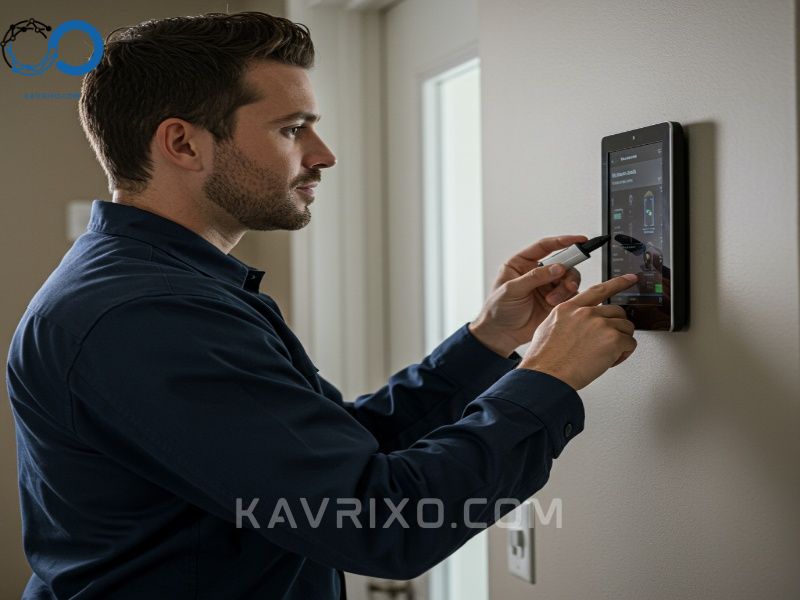
Conclusion: Securing Tomorrow, Today
The modern home security touch screen represents the pinnacle of residential protection technology. It takes complex, multi-faceted security operations and distills them into a simple, intuitive, and highly accessible user experience.
By choosing a high-quality touch screen security system, you are not just purchasing a device to monitor intrusions; you are investing in a comprehensive ecosystem that manages environmental threats, integrates seamlessly with your smart home devices, and provides immediate, reliable communication during an emergency. Whether your priority is protecting your family, safeguarding valuables, or simply enjoying the convenience of centralized home management, the interactive touch screen is undeniably the smartest, most effective control point for securing your future.
